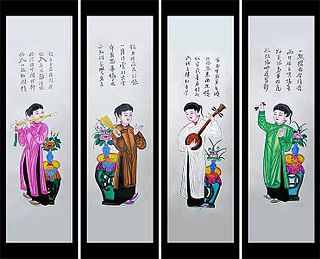 W
WVietnamese folk religion or Vietnamese indigenous religion, is the ethnic religion of the Vietnamese people. About 45.3% of the population in Vietnam are associated with this religion, making it dominant in Vietnam.
 W
WBà Chúa Kho is a goddess of Vietnamese folk religion, with her temple in Bắc Ninh. She is one of the new popular goddess like Bà Chúa Xứ, Lady of the Realm.
 W
WBà Chúa Xứ or Chúa Xứ Thánh Mẫu is a prosperity goddess worshiped in the Mekong Delta region as part of Vietnamese folk religions. She is a tutelary of business, health, and a protector of the Vietnamese border. She is considered prestigious and is worshipped in her temple in Vĩnh Tế village at the foot of Sam Mountain, An Giang province. A three-day festival is held in the village at the beginning of the rainy season, beginning on the twenty-third day of the fourth lunar month, in her honour. Bà Chúa Xứ reached her peak of popularity in the 1990s and still entertains pilgrims every year with her responsiveness to loyal followers.
 W
WĐạo Bửu Sơn Kỳ Hương refers to a religious tradition originally practiced by the mystic Đoàn Minh Huyên (1807–1856) and continued by Huỳnh Phú Sổ, founder of the Hòa Hảo. The phrase itself refers to the Thất Sơn range on the Vietnamese-Cambodian border, where Huyên, claiming to be a living Buddha,Vietnamese Folk Religion, Zen, Yiguandao sent into the world to rescue humankind, and accepted as such by followers of Hòa Hảo, is said to have made his first appearance in 1849.
 W
WĐạo Mẫu is the worship of mother goddesses which was established in Vietnam in the 16th century. While scholars like Ngô Đức Thịnh propose that it represents a systematic mother goddess, Đạo Mẫu draws together fairly disparate beliefs and practices. These include the worship of goddesses such as Thiên Y A Na, The Lady of the Realm, The Lady of the Storehouse and Princess Liễu Hạnh, legendary figures like Âu Cơ, the Trưng Sisters, and Lady Triệu, as well as the branch Four Palaces.
 W
WHungry ghost is a concept in Chinese Buddhism, Chinese traditional religion, Vietnamese Buddhism and Vietnamese traditional religion representing beings who are driven by intense emotional needs in an animalistic way. The terms 餓鬼 èguǐ and quỷ đói, literally "hungry ghost", are the Chinese and Vietnamese translation of the term preta in Buddhism. "Hungry ghosts" play a role in Chinese Buddhism, Vietnamese Buddhism and Taoism as well as in Chinese folk religion and Vietnamese folk religion. The term is not to be confused with the generic term for "ghost" or damnation, 鬼 guǐ. The understanding is that all people become such a regular ghost when they die, and would then slowly weaken and eventually die a second time. Hungry ghosts, by contrast, are a much more exceptional case, and would only occur in very unfortunate circumstances, such as if a whole family were killed or when a family no longer venerated their ancestors.
 W
WLên đồng is a ritual practiced in Vietnamese folk religion, in which followers become spirit mediums for various kinds of spirits.
 W
WPrincess Liễu Hạnh is one of The Four Immortals in Vietnamese folk religion, and also a leading figure in the mother goddess cult Đạo Mẫu, in which she governs the celestial realm.
 W
WThe Thánh Trần worship is a spiritual practice in Vietnamese folk religion associated with the spirit of historical general Trần Hưng Đạo, who repulsed the Mongolian invasions. The shrines are sometimes collectively called Trần Triều, literally "Trần dynasty".
 W
WShennong (神農), variously translated as "Divine Farmer" or "Divine Husbandman", was a mythological Chinese ruler who has become a deity in Chinese and Vietnamese folk religion. He is venerated as a culture hero in China and Vietnam.
 W
WWhale worship is a practice of animal worship, which is practiced mainly in Vietnam and some parts of Japan.